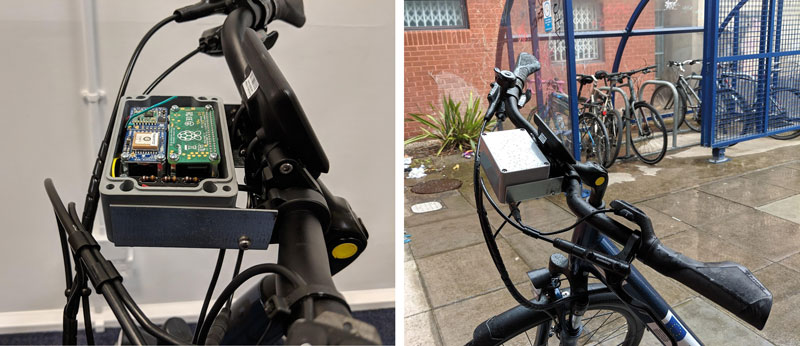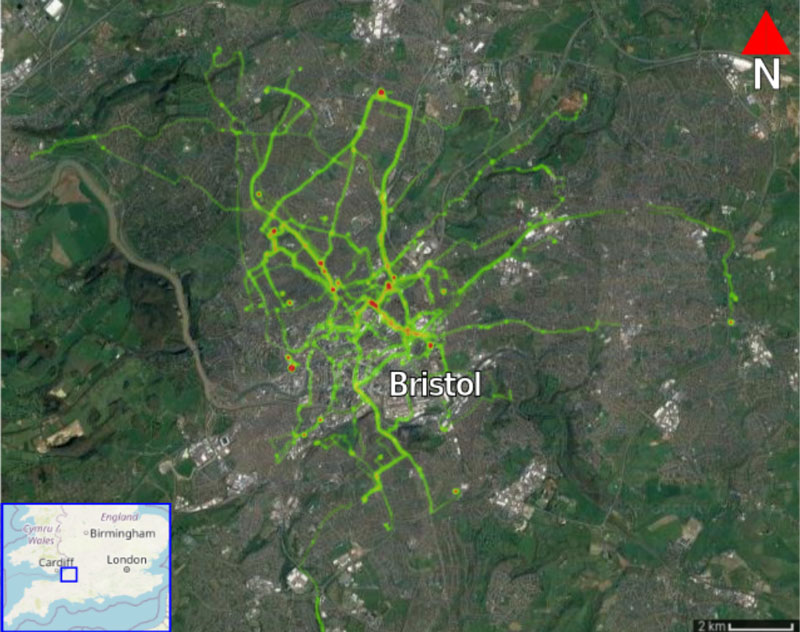by Sam Gunner, Eddie Wilson and Theo Tryfonas (University of Bristol)
As part of the Horizon 2020 Lighthouse Project REPLICATE, a fleet of electric bikes (e-bikes) were fitted with novel monitoring equipment. This hardware integrates into the e-bike’s electrical system, harvesting power from the e-bike’s battery and gathering data from its internal communications bus. Data has already been gathered from 3,000 journeys, covering more than 7,000 km, recording user behaviour for every single pedal stroke. This data creates a powerful detailed insight into the use of e-bikes in relation to variables such as topology, weather and remaining power – one pedal stroke at a time.
Electric bike (e-bilke) usage has increased significantly over the last five years, and has been accelerated by the pandemic, which forced people away from public transport [1]. e-bilkes provide a novel opportunity for telematics, the applications for which range from supporting the logistics of e-bilke cycle hire schemes, to understanding cyclist choice and the impact electric bike usage has on an individual's health.
In Bristol (UK) such a telematics system was created as part of the REPLICATE Horizon 2020 Lighthouse Project [L1]. An e-bilke cycle-sharing scheme was implemented as part of its mobility interventions, and information was generated to understand how the fleet was being used. Rather than depending on manual surveys, which are often unreliable, the University of Bristol project team, including members of the University's UKCRIC Urban Observatory [L2], developed a tracking device that would integrate into the e-bilke’s onboard electrical system. This not only removed the requirement for the telematics device’s battery to be independently charged, but also meant that messages on the e-bilke’s CAN bus (a “control area network” protocol widely used in the automotive industry) could be captured and stored, providing extremely detailed information about the state of the e-bilke system, such as battery level, motor power, pedal torque and cadence.
Instrumentation and system development
We started developing the telematics system in October 2017, and a significant amount of reverse engineering was needed to understand how the electrical system of an e-bilke could be modified in a way that was safe and would not negatively impact the operation of the e-bilke. A single board computer-based design was selected, and this platform was augmented to include a GPS, CAN bus interface, accelerometer, buck-boost converter, internal battery and LoRaWAN interface to allow the device to report amalgamated statics whenever within range of a ‘The Things Network’ access point. WiFi connectivity was used to upload complete log files for a journey, with each file often being several megabytes in size.
An open-source data “pipeline” was implemented on a University of Bristol–based server. Telematics devices automatically encrypt log files and upload them via WiFi at the end of a journey. These files are then unencrypted by the server, which processes the raw CAN bus messages before storing them in a time series database. Message broker-based middleware was implemented [2] to allow authorised applications to receive both the raw and processed messages in real time. Web-based visualisation software was also implemented, allowing GPS and user data to be investigated together.
As shown in Figure 1, the telematics electronics were fitted inside a waterproof enclosure, and a mounting bracket was developed that would allow the device to be fitted to the handlebar of the host e-bilke. Passthrough cabling was developed, allowing signals to be intercepted between the e-bilke electric drive and display. Standard connectors were employed, meaning that the system could be fitted quickly without needing the e-bilke to be taken to a workshop.
Twelve devices were built, and all were installed on 16th April 2019. This deployment ran for two years, concluding with the end of REPLICATE. During that time 2,957 journeys were recorded, covering a total distance of 7,320 km. The only telematics failure was due to a corrupt SD card on one of the units, and at no point during the deployment did the telematics systems negatively impact the operation of the e-bilkes themselves. The system provided the information required by the REPLICATE Project, as well as a huge amount of other data which continues to provide opportunities for ongoing research.

Figure 1: The E-bike Telematics System: (left) the devices fitted to a host e-bike during a lab trail. The lid of the waterproof enclosure has been removed to expose the internal electronics; and (right) the device after it has been fitted to an e-bike as part of the two-year-long REPLICATE technology deployment.
The data and insights
The REPLICATE e-bilke telematics system generates an extremely rich dataset, providing insights into many aspects of e-bilke usage. The onboard GPS records a complete trace of each journey from start to finish. Individual journeys can be inspected to understand the route selection choices that an e-bilke rider has made, for example, demonstrating situations where a traffic-free route has been selected despite this adding distance to a journey. With nearly 3,000 journeys recorded, the data also builds a picture of the popularity of different links within the City of Bristol road network, showing which sections e-bilke users regularly avoid. Figure 2 shows a heatmap of such journeys recorded by the telematics system during June 2019. Data from the telematics system has already been shared with the local authority in the hope that it will support them in understanding which parts of the city would benefit most from improved cycle infrastructure.

Figure 2: A heat map showing the GPS data recorded by the e-bike telematics system during June 2019.
In addition, the CAN bus data provides useful insights into how the e-bilke is being ridden. Values that are recorded include the battery status, the amount of power going to the electric drive, the amount of torque being applied through the pedals, the pedal cadence and the speed of wheel rotation. Each of these values is recorded at a frequency of 20 Hz, providing extremely fine-grained quantitative visibility of many ride features, such as, an e-bilke user’s dependence on the e-bilke electric assistance, and how this alters over time. This could help researchers understand the short- and long-term health implications of e-bilke adoption.
This e-bilke telematics system has already formed the basis of further funding applications for a number of studies, focusing on topics ranging from e-cargo-bike logistics to how e-bilke usage can help avoid early mortality in the over 55s. We look forward to the utilisation of the technology continuing.
This work was supported by the European Union’s Horizon 2020 Research and Innovation Programme under grant agreement No. 691735 (project REPLICATE). It was also supported by UK Government funding, under the UKCRIC Urban Observatories programme (grant number EP/P016782/1).
Links:
[L1] https://replicate-project.eu/
[L2] https://urbanobservatory.ac.uk/explore/ukcric
References:
[1] Kazemzadeh, Khashayar, and T. Koglin: “Electric bike (non) users’ health and comfort concerns pre and peri a world pandemic (COVID-19): A qualitative study”, Journal of Transport & Health, 20, 2021.
[2] Mavromatis, Gunner, Tryfonas and Simeonidou: “Dynamic Cloud Service Management for Scalable Internet of Things Applications”, IEEE Smart World Congress and the 3rd IEEE Conference on Smart City Innovations (IEEE SCI 2019), Leicester, UK. DOI: 10.1109/SmartWorld-UIC-ATC-SCALCOM-IOP-SCI.2019.00345
Please contact:
Sam Gunner,
University of Bristol, UK











